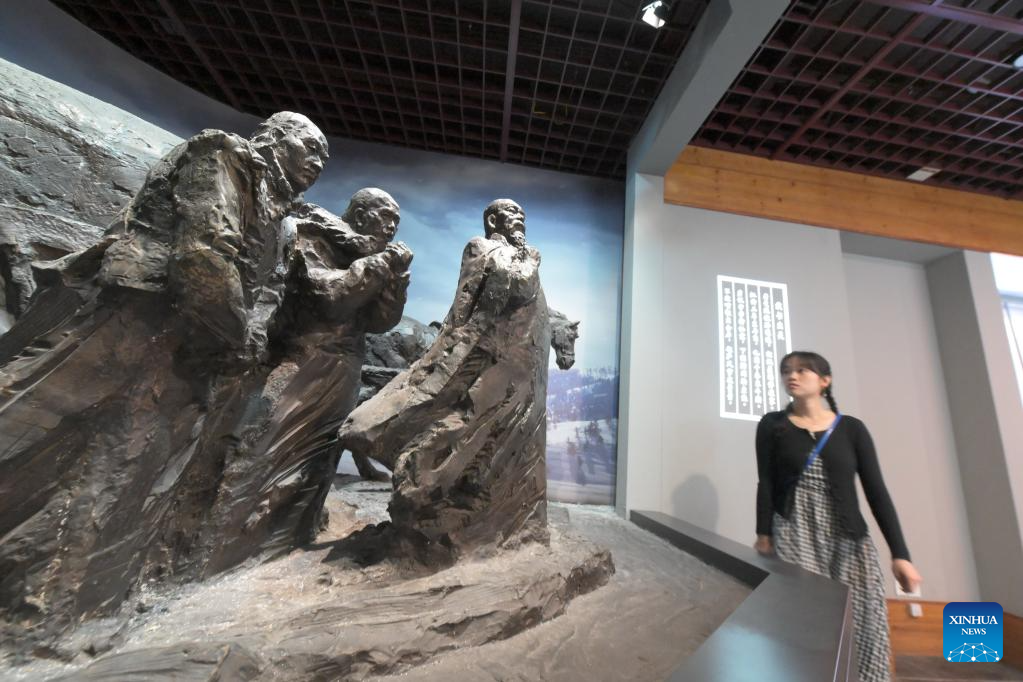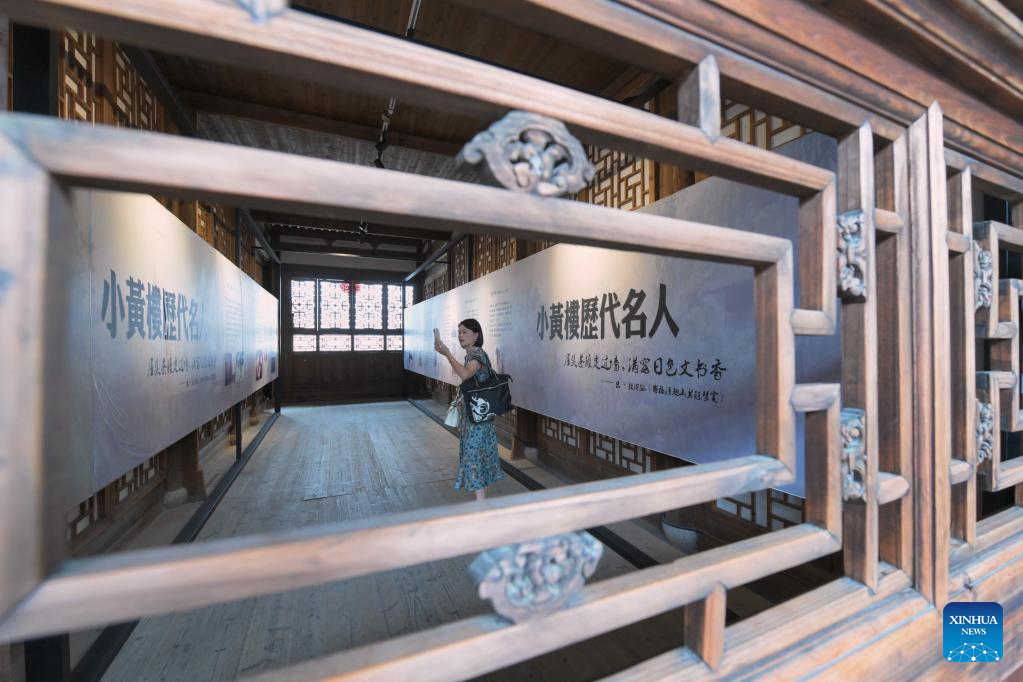
A tourist walks past the former residence of Lin Juemin, a renowned revolutionary hero, in Sanfangqixiang (the Three Lanes and Seven Alleys) in Fuzhou, southeast China's Fujian Province, June 14, 2023. Sanfangqixiang, or the Three Lanes and Seven Alleys, is a 40-hectare complex famous for its traditional urban fabric of lanes and alleys. The green slate walkways are lined by ancestral houses, featuring white walls and black tiles.
Initially built in the Jin Dynasty (265-420), the neighborhood developed in the Tang Dynasty (618-907) and the Five Dynasties (907-960), and thrived in the Ming and Qing dynasties (1368-1911). Sanfangqixiang, dubbed a museum of Ming and Qing dynasties' architecture, now boasts over 200 ancient buildings. (Xinhua/Lin Shanchuan)

A tourist visits the former residence of Yan Fu, a renowned Chinese thinker, educator and translator, in Sanfangqixiang (the Three Lanes and Seven Alleys) in Fuzhou, southeast China's Fujian Province, June 13, 2023. Sanfangqixiang, or the Three Lanes and Seven Alleys, is a 40-hectare complex famous for its traditional urban fabric of lanes and alleys. The green slate walkways are lined by ancestral houses, featuring white walls and black tiles.
Initially built in the Jin Dynasty (265-420), the neighborhood developed in the Tang Dynasty (618-907) and the Five Dynasties (907-960), and thrived in the Ming and Qing dynasties (1368-1911). Sanfangqixiang, dubbed a museum of Ming and Qing dynasties' architecture, now boasts over 200 ancient buildings. (Xinhua/Lin Shanchuan)

This aerial photo taken on June 12, 2023 shows a view of Sanfangqixiang (the Three Lanes and Seven Alleys) in Fuzhou, southeast China's Fujian Province. Sanfangqixiang, or the Three Lanes and Seven Alleys, is a 40-hectare complex famous for its traditional urban fabric of lanes and alleys. The green slate walkways are lined by ancestral houses, featuring white walls and black tiles.
Initially built in the Jin Dynasty (265-420), the neighborhood developed in the Tang Dynasty (618-907) and the Five Dynasties (907-960), and thrived in the Ming and Qing dynasties (1368-1911). Sanfangqixiang, dubbed a museum of Ming and Qing dynasties' architecture, now boasts over 200 ancient buildings. (Xinhua/Lin Shanchuan)

This photo taken on June 12, 2023 shows a view of Nanhou Street in Sanfangqixiang (the Three Lanes and Seven Alleys) in Fuzhou, southeast China's Fujian Province. Sanfangqixiang, or the Three Lanes and Seven Alleys, is a 40-hectare complex famous for its traditional urban fabric of lanes and alleys. The green slate walkways are lined by ancestral houses, featuring white walls and black tiles.
Initially built in the Jin Dynasty (265-420), the neighborhood developed in the Tang Dynasty (618-907) and the Five Dynasties (907-960), and thrived in the Ming and Qing dynasties (1368-1911). Sanfangqixiang, dubbed a museum of Ming and Qing dynasties' architecture, now boasts over 200 ancient buildings. (Xinhua/Lin Shanchuan)

A tourist walks past the former residence of Yan Fu, a renowned Chinese thinker, educator and translator, in Sanfangqixiang (the Three Lanes and Seven Alleys) in Fuzhou, southeast China's Fujian Province, June 9, 2023. Sanfangqixiang, or the Three Lanes and Seven Alleys, is a 40-hectare complex famous for its traditional urban fabric of lanes and alleys. The green slate walkways are lined by ancestral houses, featuring white walls and black tiles.
Initially built in the Jin Dynasty (265-420), the neighborhood developed in the Tang Dynasty (618-907) and the Five Dynasties (907-960), and thrived in the Ming and Qing dynasties (1368-1911). Sanfangqixiang, dubbed a museum of Ming and Qing dynasties' architecture, now boasts over 200 ancient buildings. (Xinhua/Lin Shanchuan)

This aerial photo taken on June 12, 2023 shows a corner of Sanfangqixiang (the Three Lanes and Seven Alleys) in Fuzhou, southeast China's Fujian Province. Sanfangqixiang, or the Three Lanes and Seven Alleys, is a 40-hectare complex famous for its traditional urban fabric of lanes and alleys. The green slate walkways are lined by ancestral houses, featuring white walls and black tiles.
Initially built in the Jin Dynasty (265-420), the neighborhood developed in the Tang Dynasty (618-907) and the Five Dynasties (907-960), and thrived in the Ming and Qing dynasties (1368-1911). Sanfangqixiang, dubbed a museum of Ming and Qing dynasties' architecture, now boasts over 200 ancient buildings. (Xinhua/Lin Shanchuan)

This aerial photo taken on June 13, 2023 shows a view of the Lin Zexu Memorial Hall in Sanfangqixiang (the Three Lanes and Seven Alleys) in Fuzhou, southeast China's Fujian Province. Lin Zexu, a Qing Dynasty (1644-1911) official, led the fight against opium smuggling. Sanfangqixiang, or the Three Lanes and Seven Alleys, is a 40-hectare complex famous for its traditional urban fabric of lanes and alleys. The green slate walkways are lined by ancestral houses, featuring white walls and black tiles.
Initially built in the Jin Dynasty (265-420), the neighborhood developed in the Tang Dynasty (618-907) and the Five Dynasties (907-960), and thrived in the Ming and Qing dynasties (1368-1911). Sanfangqixiang, dubbed a museum of Ming and Qing dynasties' architecture, now boasts over 200 ancient buildings. (Xinhua/Lin Shanchuan)

This aerial photo taken on June 14, 2023 shows a view of the former residence of Lin Juemin, a renowned revolutionary hero, in Sanfangqixiang (the Three Lanes and Seven Alleys) in Fuzhou, southeast China's Fujian Province. Sanfangqixiang, or the Three Lanes and Seven Alleys, is a 40-hectare complex famous for its traditional urban fabric of lanes and alleys. The green slate walkways are lined by ancestral houses, featuring white walls and black tiles.
Initially built in the Jin Dynasty (265-420), the neighborhood developed in the Tang Dynasty (618-907) and the Five Dynasties (907-960), and thrived in the Ming and Qing dynasties (1368-1911). Sanfangqixiang, dubbed a museum of Ming and Qing dynasties' architecture, now boasts over 200 ancient buildings. (Xinhua/Lin Shanchuan)

A tourist visits Lin Zexu Memorial Hall in Sanfangqixiang (the Three Lanes and Seven Alleys) in Fuzhou, southeast China's Fujian Province, June 13, 2023. Lin Zexu, a Qing Dynasty (1644-1911) official, led the fight against opium smuggling. Sanfangqixiang, or the Three Lanes and Seven Alleys, is a 40-hectare complex famous for its traditional urban fabric of lanes and alleys. The green slate walkways are lined by ancestral houses, featuring white walls and black tiles.
Initially built in the Jin Dynasty (265-420), the neighborhood developed in the Tang Dynasty (618-907) and the Five Dynasties (907-960), and thrived in the Ming and Qing dynasties (1368-1911). Sanfangqixiang, dubbed a museum of Ming and Qing dynasties' architecture, now boasts over 200 ancient buildings. (Xinhua/Lin Shanchuan)

A tourist visits the former residence of Lin Juemin, a renowned revolutionary hero, in Sanfangqixiang (the Three Lanes and Seven Alleys) in Fuzhou, southeast China's Fujian Province, June 14, 2023. Sanfangqixiang, or the Three Lanes and Seven Alleys, is a 40-hectare complex famous for its traditional urban fabric of lanes and alleys. The green slate walkways are lined by ancestral houses, featuring white walls and black tiles.
Initially built in the Jin Dynasty (265-420), the neighborhood developed in the Tang Dynasty (618-907) and the Five Dynasties (907-960), and thrived in the Ming and Qing dynasties (1368-1911). Sanfangqixiang, dubbed a museum of Ming and Qing dynasties' architecture, now boasts over 200 ancient buildings. (Xinhua/Lin Shanchuan)

A tourist visits an ancient building in Sanfangqixiang (the Three Lanes and Seven Alleys) in Fuzhou, southeast China's Fujian Province, June 13, 2023. Sanfangqixiang, or the Three Lanes and Seven Alleys, is a 40-hectare complex famous for its traditional urban fabric of lanes and alleys. The green slate walkways are lined by ancestral houses, featuring white walls and black tiles.
Initially built in the Jin Dynasty (265-420), the neighborhood developed in the Tang Dynasty (618-907) and the Five Dynasties (907-960), and thrived in the Ming and Qing dynasties (1368-1911). Sanfangqixiang, dubbed a museum of Ming and Qing dynasties' architecture, now boasts over 200 ancient buildings. (Xinhua/Lin Shanchuan)



